|
|
|
Sort Order |
|
|
|
Items / Page
|
|
|
|
|
|
|
| Srl | Item |
| 1 |
ID:
105857
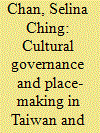

|
|
|
|
|
| Publication |
2011.
|
| Summary/Abstract |
This article compares cultural governance in Taiwan and China through their respective place-making processes. It investigates how cultural polices objectify tradition and popularize cultural landscape in local places for economic development and identity politics. Contrary to what would be commonly expected, the Chinese government adopted a minimalist approach while the Taiwanese government was much more hands-on. The sociopolitical histories of the two governments and their objectives are examined to understand this difference. In addition, the reactions of the locals to cultural policies in the two places are also contrasted. Finally, the different effects of cultural governance in China and Taiwan are examined. In particular, it was found that communal relations have deteriorated in China but strengthened in Taiwan as a result.
|
|
|
|
|
|
|
|
|
|
|
|
|
|
|
|
| 2 |
ID:
185934
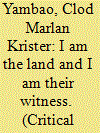

|
|
|
|
|
| Summary/Abstract |
What happens to place-based, intergenerational knowledge in conditions of displacement? Here we attempt an answer to this question by reflecting on the experiences of the Indigenous peoples of Mindanao in the southern Philippines, collectively known as Lumads. For decades, Lumad communities have faced violence and displacement at the hands of the Philippine military, corporate armies, civilian militias, and rebel groups. Most accounts of Lumads portray them as passive victims who are “caught in between” warring factions of capitalists and leftists. This paper aims to augment a small but growing body of work that challenges such accounts and centers the historical agency of Lumads. In particular, we highlight some of the ways in which Lumads make life, place, and memory in the schools and community centers that they have established at three sites in Mindanao and Manila. In becoming Lumad places, these are sites in which Lumads of different ages, ethnicities, and social standings actively remake their relations with themselves, with their surroundings, and with others; they are sites of intergenerational communication and consternation; they are sites of pan-ethnic identity formation and solidarity; and they are sites of despair, repair, and potentially transformation.
|
|
|
|
|
|
|
|
|
|
|
|
|
|
|
|
| 3 |
ID:
178155
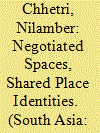

|
|
|
|
|
| Summary/Abstract |
Succeeding waves of mobilisation for the separate state of Gorkhaland has left an indelible imprint on the cultural, political and urban landscape of the Darjeeling Hills. Based on empirical research, this paper tries to explore the intricate relationship between ethnicity, place and politics of belonging in the Himalayan town of Kalimpong. It specifically tries to locate the interface between political events and the transformation of the urban landscape by taking into consideration the growth of roadside settlements. While noting the specific contours of these settlements, their culture and their liminal condition, the paper tries to address the issues pertaining to place-making and identity formation in the Himalayan region.
|
|
|
|
|
|
|
|
|
|
|
|
|
|
|
|
| 4 |
ID:
192861
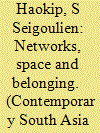

|
|
|
|
|
| Summary/Abstract |
This article aims to supplement existing economic analyses of the Marwari mercantile network by exploring how the network is both grounded spatially and reproduced culturally in Manipur. It discusses some of the economic and socio-cultural practices adopted by the Marwari merchants in Manipur including their business activities, marriage patterns and temple construction. In so doing, it highlights the nature of relationships between these practices and how they are connected to their mercantile network at large. The article also illustrates how merchant communities such as the Marwaris carve out their own space through cultural processes of place-making in a contested place like Manipur. Elucidating how the Marwari mercantile network gets reproduced culturally, it reveals the ways in which networks of capital relate to distinct spatial configurations – in this case, borderland. In turn, the above process also delineates how the idea of belonging for the Marwari merchants is emplaced and shaped at the same time by their mercantile network. Based primarily on interviews, observation and some documents, the materials used in this article stem mainly from Imphal and some from Churachandpur.
|
|
|
|
|
|
|
|
|
|
|
|
|
|
|
|
| 5 |
ID:
143643
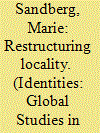

|
|
|
|
|
| Summary/Abstract |
Taking cities as analytical entry points for investigating practice, identity and place-making, this article explores the differential restructurings of locality in the twin cities of Görlitz and Zgorzelec on the German-Polish border. Drawing on ethnographic fieldwork, it shows how the local cities′ leaderships are attempting to wrestle the cities out of their downmarket positioning in the global economy. Deploying a performative research strategy of methodological relationalism, the article examines intersections between these cities′ strategies of situating local youth within urban regeneration and cross-border projects and local youth′s preferences for engaging in other kinds of place-making. By ‘seeing’ the cities in border regions through practices of place-making within the multiscalar processes of urban regeneration, new insights about ‘place’ are generated in which city branding is not the only kind of local restructuring to be acknowledged.
|
|
|
|
|
|
|
|
|
|
|
|
|
|
|
|
|
|
|
|
|